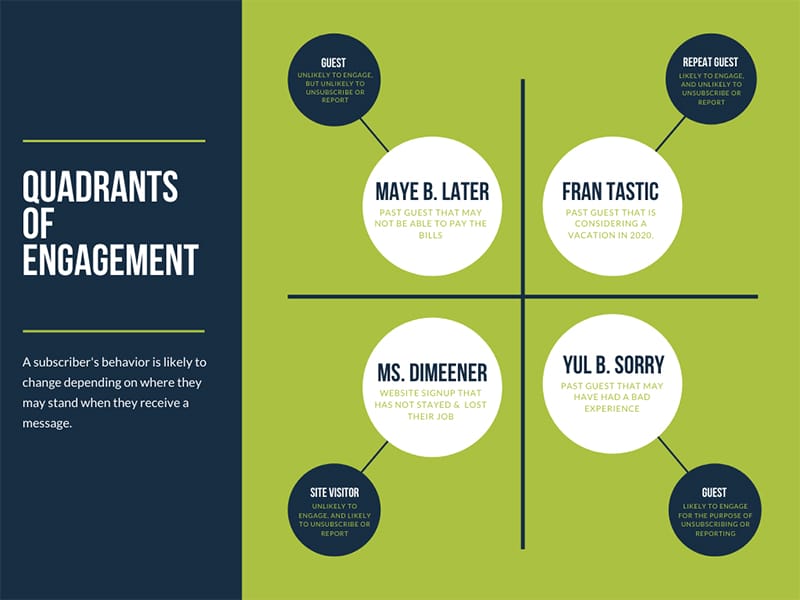In the wake of COVID-19, it’s no surprise that the hospitality and travel industry has been hit hard. Canceled events, flight restrictions, and social distancing wreak havoc on businesses who rely on attendance and in-person interaction.
On the bright side, business will resume eventually, and, when it does, corporate messaging will be more critical than ever.
In these unprecedented times, are you unsure of what message you should send to your contacts post COVID-19? Campaign Monitor can help.
COVID-19’s impact on the hospitality industry
While the impact of COVID-19 is far-reaching, its effect on hospitality and travel companies has been especially impactful. Travel restrictions and social distancing have led to economic concerns for the industry. OAG Aviation Worldwide has reported that restrictions on international flights have caused up to $880 billion in losses for the global airline industry. According to Smith Travel Research, American hotel occupancy has fallen to 53%. The World Travel and Tourism Council reports that, in the tourism and travel industry, 50 million jobs worldwide could be at risk.
Safety is a top priority. Companies have responded to this time of uncertainty with business closures and staff reductions. They’re also taking measures to try to be more responsive to the needs of their customers. Flexible cancellation policies, amended loyalty programs, waived rebooking fees, and regular online communication are some of the ways businesses are trying to maintain a positive relationship with their users.
Communication is key.
In times of crisis, communication is of the utmost importance. In a recent study, 54% of consumers indicated that they use the internet more frequently since the onslaught of COVID-19. Consumers are looking to their email for information. There’s a strong need now for businesses to communicate clear expectations, keep customers informed, and maintain contact with followers via email marketing.
However, there’s a careful balance of maintaining customer loyalty while remaining sensitive to the consumers’ experience during this global pandemic. With so much communication happening at once, you don’t want to get lost in the noise of your competitors or pester your audience.
Source: Twitter
Consumers are also turned off by the idea of companies capitalizing on a crisis situation. If a reader views your email as strictly a sales tool, your marketing plan could actually be hurting your business.
Your email campaign needs to be carefully strategized, providing essential information while remaining mindful of the public’s current mindset. Following this plan can help you stand out from other businesses while building customer loyalty.
Assess consumer engagement.
In today’s tumultuous times, consumer engagement has likely changed. Your customers aren’t in the same frame of mind they were before COVID-19, so your usual marketing messages may not have the same effect.
Consumers have a new sense of fear for their health and safety. Their economic standing may have changed as a result of furloughed jobs or reduced hours at work, and your offers and specials may not be the draw they once were.
Understanding your customer’s mindset can help you create an effective communication strategy.
Source: FuelTravel
As you plan your email communications, keep in mind that visitors want to be aware of any potential health concerns. Additionally, guests need money to travel. Between furloughed jobs and non-essential business shutdowns, the economic impact of COVID-19 is extensive.
The Washington Post recently reported that 3.3 million Americans have filed for unemployment since the virus outbreak. That’s 3.3 million people who no longer have the financial means for leisurely travel.
Lastly, guests need to have their fears abated to feel comfortable traveling. Because it’s difficult to predict what’ll happen with the spread of COVID-19, consumers may find themselves in the following categories:
- Adventurous: tired of social distancing and anxious to get back on the road
- Cautious: unpredictable current social climate will impact their long-term travel decisions
- Middle of the road: somewhere between Adventurous and Cautious
Keep these concepts in mind as you move forward with your digital marketing plan.
Recover your business after COVID-19 with these 4 emails.
Crisis communication is important during a global pandemic. But it’s the messaging after a catastrophe that can really affect business. That’s when people are looking for answers and direction. Customers want to know what happens now: As a consumer, what are my next steps?
While it’s impossible to know when people will be prepared to travel again, hospitality and travel businesses should be planning their messaging now. As communities begin to rebound from the COVID-19 pandemic, government stimulus and other programs may help minimize the effects on the economy and help support sufficient demand for travel services.
To rebuild once the COVID-19 pandemic subsides, hospitality and travel companies should consider reaching their audience with a planned monthly email strategy. Use these four email messages whose purpose coincides with travel demand.
1. Open for business
Your first month’s message post-COVID-19 should reach past and potential guests. It should serve as an announcement that you’re open for business and a viable option for visitors’ travel needs. This could be a thank you message showing your appreciation for customer loyalty or it could be the announcement of a re-opening event with special offers.
Either way, messaging ought to be sensitive to consumers’ post-pandemic mentality. Many may still be fearful of the prospect of travel. Allay those fears by letting visitors know what steps you’re taking to provide a clean and safe environment.
Source: RedRoof
Include information about any new amenities you may be offering to help visitors feel that their health and safety is a top priority. Think keyless entry for room doors and online check-in for minimal human contact. Provide links to instructional information for new technological developments, so customers know what to expect upon arrival.
Source: Criton
This is also the time to address common questions such as date flexibility, cancelation policy, and whether area restaurants and shops have resumed operation. Essentially, messaging should be thoughtful and address consumer concerns. You want to instill confidence in your guests while alerting them that your business is accepting bookings.
2. Plan for the future.
Your next email should look to the future and instill a sense of hope for your guests. Many people may not be in the financial position to book a trip right away. But, after months of obeying social distancing and stay-at-home policies, people will be ready to start planning for a future get-away. This email might include enticing destination photos to inspire the planning of an upcoming vacation.
Source: Really Good Emails
It could also highlight special offers for savings to customers who book in advance. This ensures income for your business while building customer loyalty.
Source: Smarter HQ
Even though travel restrictions will be lifted and businesses will be reopened, it may take time for people to feel comfortable resuming familiar activity. If you have a sense that guests aren’t quite ready to venture out, this email could offer an uplifting message of hope. Let them know you’ll be available when they’re ready to travel again.
Source: Search Engine Watch
3. Encourage a longer stay.
By the third month after the COVID-19 pandemic subsides, travel demand will continue to rise. Now is the time to focus messaging on packages that increase the length of stay and maximize booking values. Extending a guest’s stay benefits you because the longer they stay, the more they’ll spend in booking fees and on additional services.
To encourage a guest to stay longer, consider offering incentives like discounted rates, special ancillary packages, or free “extras.” These offerings help build customer loyalty, as guests see these bonuses as perks. At the same time, your business reaps the rewards.
Source: Really Good Emails
Discounted meals, preferential spa packages, and waived amenity fees are all ways to entice customers to book a longer stay.
4. Establish a sense of normalcy.
At this point, it’s time to target visitors based on their actual intent to book travel plans with you. Travel demands will continue to stabilize, and guests will soon come to find this time as the new normal. Your email message should now focus on information like seasonal bookings and outline expectations for what these bookings will entail.
Identify ways you’ll provide the outstanding service your guests have come to expect. Give a sense that your business is stable and prepared to help create a memorable trip for your visitors.
Source: Really Good Emails
This email can serve to assure visitors that bookings are solid. Health and safety, while always a concern, are no longer a risk. Customers can feel confident in committing to travel plans and, more importantly, to making those travel plans with you.
Wrap up
While businesses today are navigating uncharted waters, the hospitality and travel industry can recover through calculated email messaging after COVID-19. A monthly communication plan should consist of four emails that:
- Announce you’re open for business and dispel potential fears
- Help guests to see past the uncertainty of the present and look forward to planning for the future
- Entice visitors to book a longer stay
- Establish a sense of normalcy
Sensitive messaging that keeps past and future guests informed of post-pandemic policies while promoting special pricing and offers can build confidence, encourage customer loyalty, and help your business succeed.
For more helpful tips about email marketing after COVID-19, subscribe to our weekly newsletter, where we’ll be sending you the latest content.














